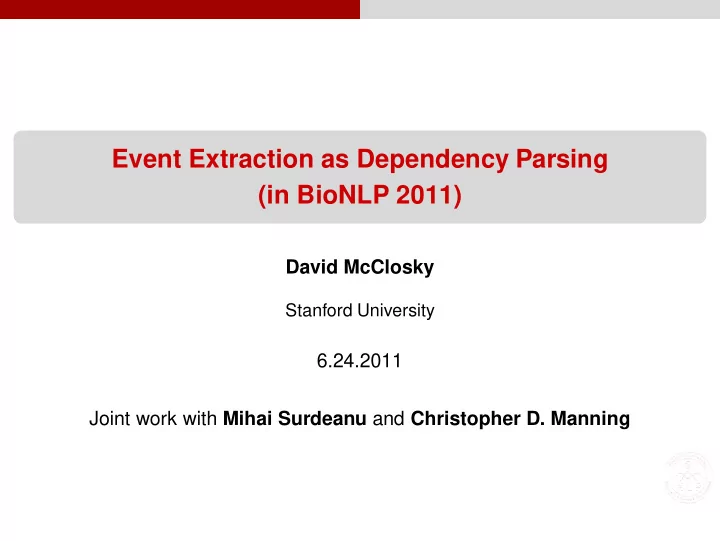

Event Extraction as Dependency Parsing (in BioNLP 2011) David McClosky Stanford University 6.24.2011 Joint work with Mihai Surdeanu and Christopher D. Manning
Summary Event parsing Our approach in two slides... David McClosky (Stanford) Event Parsing in BioNLP 2011 6.24.2011 1 / 10
Summary Event parsing Our approach in two slides... Full details in [McClosky, Surdeanu, and Manning, ACL 2011] David McClosky (Stanford) Event Parsing in BioNLP 2011 6.24.2011 1 / 10
Road map You are here. Outline Event Parsing 1 Adapting to BioNLP 2011 2 3 Experiments Conclusion 4 David McClosky (Stanford) Event Parsing in BioNLP 2011 6.24.2011 2 / 10
Event Parsing Overview Approach Preprocessing: Segmentation, tokenization David McClosky (Stanford) Event Parsing in BioNLP 2011 6.24.2011 3 / 10
Event Parsing Overview Approach Preprocessing: Segmentation, tokenization, syntactic parsing Self-trained biomedical parser: [McClosky, 2010] David McClosky (Stanford) Event Parsing in BioNLP 2011 6.24.2011 3 / 10
Event Parsing Overview Approach Anchor classification: Token classification for event anchors orne et al. , BioNLP 2009] ) (similar to [Bj¨ David McClosky (Stanford) Event Parsing in BioNLP 2011 6.24.2011 3 / 10
Event Parsing Overview Approach Event parsing: Parse anchors and proteins using reranking parser David McClosky (Stanford) Event Parsing in BioNLP 2011 6.24.2011 3 / 10
Event Parsing Motivation Maximum-spanning tree based parsing Why a dependency parser? Event structures are non-projective (non-planar) David McClosky (Stanford) Event Parsing in BioNLP 2011 6.24.2011 4 / 10
Event Parsing Motivation Maximum-spanning tree based parsing Why a dependency parser? Event structures are non-projective (non-planar) Why MSTParser? [McDonald et al. , EMNLP 2005] Handles non-projective trees naturally David McClosky (Stanford) Event Parsing in BioNLP 2011 6.24.2011 4 / 10
Event Parsing Motivation Maximum-spanning tree based parsing Why a dependency parser? Event structures are non-projective (non-planar) Why MSTParser? [McDonald et al. , EMNLP 2005] Handles non-projective trees naturally Easy to extend feature extractor David McClosky (Stanford) Event Parsing in BioNLP 2011 6.24.2011 4 / 10
Event Parsing Motivation Maximum-spanning tree based parsing Why a dependency parser? Event structures are non-projective (non-planar) Why MSTParser? [McDonald et al. , EMNLP 2005] Handles non-projective trees naturally Easy to extend feature extractor Support for n -best parsing David McClosky (Stanford) Event Parsing in BioNLP 2011 6.24.2011 4 / 10
Adapting to BioNLP 2011 Overview Adapting to BioNLP 2011 General improvements Distributional similarity features in anchor detection David McClosky (Stanford) Event Parsing in BioNLP 2011 6.24.2011 5 / 10
Adapting to BioNLP 2011 Overview Adapting to BioNLP 2011 General improvements Distributional similarity features in anchor detection Improved head percolation rules for multiword anchors David McClosky (Stanford) Event Parsing in BioNLP 2011 6.24.2011 5 / 10
Adapting to BioNLP 2011 Overview Adapting to BioNLP 2011 General improvements Distributional similarity features in anchor detection Improved head percolation rules for multiword anchors Using lemmas (along with word forms) during event parsing David McClosky (Stanford) Event Parsing in BioNLP 2011 6.24.2011 5 / 10
Adapting to BioNLP 2011 Overview Adapting to BioNLP 2011 General improvements Distributional similarity features in anchor detection Improved head percolation rules for multiword anchors Using lemmas (along with word forms) during event parsing Domain-specific customization Update event type information ( EPI , ID ) David McClosky (Stanford) Event Parsing in BioNLP 2011 6.24.2011 5 / 10
Adapting to BioNLP 2011 Overview Adapting to BioNLP 2011 General improvements Distributional similarity features in anchor detection Improved head percolation rules for multiword anchors Using lemmas (along with word forms) during event parsing Domain-specific customization Update event type information ( EPI , ID ) Combine ID training data with GENIA ( ID ) David McClosky (Stanford) Event Parsing in BioNLP 2011 6.24.2011 5 / 10
Adapting to BioNLP 2011 Overview Adapting to BioNLP 2011 General improvements Distributional similarity features in anchor detection Improved head percolation rules for multiword anchors Using lemmas (along with word forms) during event parsing Domain-specific customization Update event type information ( EPI , ID ) Combine ID training data with GENIA ( ID ) Removing nested entities ( ID ) David McClosky (Stanford) Event Parsing in BioNLP 2011 6.24.2011 5 / 10
Experiments Results on Genia development Decoder(s) Parser Reranker 1P 49.0 49.4 2P 49.5 50.5 1N 49.9 50.2 2N 46.5 47.9 All — 50.7 David McClosky (Stanford) Event Parsing in BioNLP 2011 6.24.2011 6 / 10
Experiments Results on Epigenetics development Decoder(s) Parser Reranker 1P 62.3 63.3 2P 62.2 63.3 1N 62.9 64.6 2N 60.8 63.8 All — 64.1 (note: issues with our internal evaluator implementation) David McClosky (Stanford) Event Parsing in BioNLP 2011 6.24.2011 7 / 10
Experiments Domain adaptation for Infectious Diseases f -score Model Precision Recall 59.3 38.0 46.3 ID ID ( × 1) + GE 52.0 40.2 45.3 ID ( × 2) + GE 52.4 41.7 46.4 ID ( × 3) + GE 54.8 45.0 49.4 ID ( × 4) + GE 55.2 43.8 48.9 ID ( × 5) + GE 55.1 44.7 49.4 (parser only with 2N decoder) David McClosky (Stanford) Event Parsing in BioNLP 2011 6.24.2011 8 / 10
Experiments Results on Infectious Diseases development Decoder(s) Parser Reranker 1P 46.0 48.5 2P 47.8 49.8 1N 48.5 49.4 2N 49.4 48.8 All — 50.2 David McClosky (Stanford) Event Parsing in BioNLP 2011 6.24.2011 9 / 10
Conclusion Talks this short probably don’t need subsections... Summary New approach to event extraction Parsing can be used for event extraction Reranker further improves performance Minimal changes to adapt to new BioNLP domains Component in the FAUST system (stay tuned!) Code coming soon! http://nlp.stanford.edu/software/eventparsing.shtml David McClosky (Stanford) Event Parsing in BioNLP 2011 6.24.2011 10 / 10
Conclusion Talks this short probably don’t need subsections... Summary New approach to event extraction Parsing can be used for event extraction Reranker further improves performance Minimal changes to adapt to new BioNLP domains Component in the FAUST system (stay tuned!) Code coming soon! http://nlp.stanford.edu/software/eventparsing.shtml Questions? David McClosky (Stanford) Event Parsing in BioNLP 2011 6.24.2011 10 / 10
Recommend
More recommend